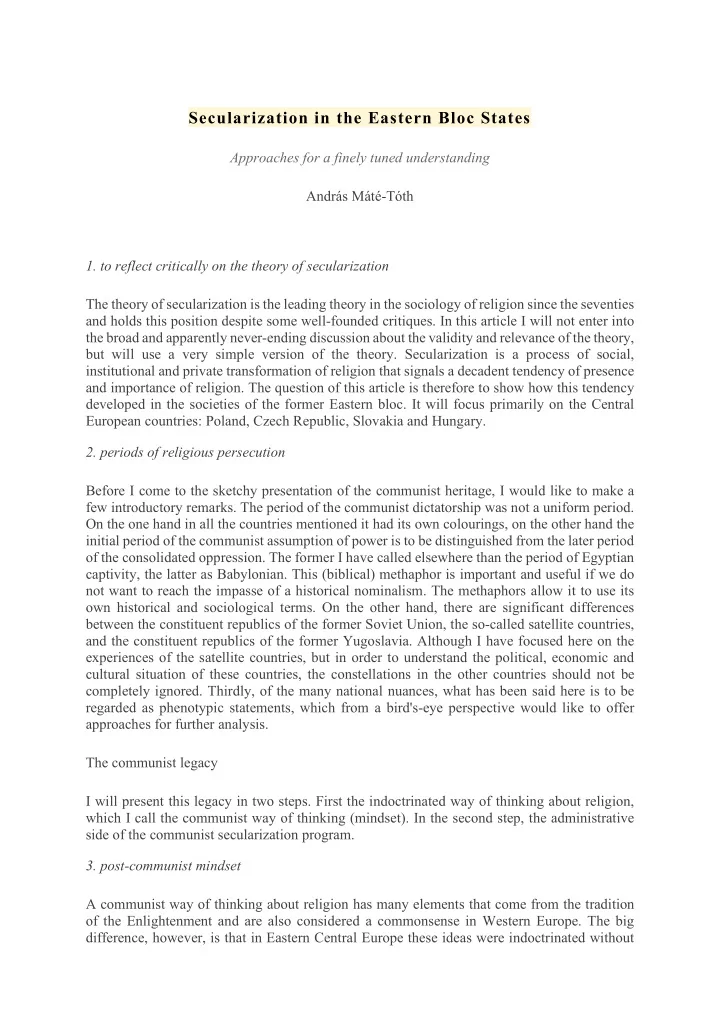

Secularization in the Eastern Bloc States Approaches for a finely tuned understanding András Máté-Tóth 1. to reflect critically on the theory of secularization The theory of secularization is the leading theory in the sociology of religion since the seventies and holds this position despite some well-founded critiques. In this article I will not enter into the broad and apparently never-ending discussion about the validity and relevance of the theory, but will use a very simple version of the theory. Secularization is a process of social, institutional and private transformation of religion that signals a decadent tendency of presence and importance of religion. The question of this article is therefore to show how this tendency developed in the societies of the former Eastern bloc. It will focus primarily on the Central European countries: Poland, Czech Republic, Slovakia and Hungary. 2. periods of religious persecution Before I come to the sketchy presentation of the communist heritage, I would like to make a few introductory remarks. The period of the communist dictatorship was not a uniform period. On the one hand in all the countries mentioned it had its own colourings, on the other hand the initial period of the communist assumption of power is to be distinguished from the later period of the consolidated oppression. The former I have called elsewhere than the period of Egyptian captivity, the latter as Babylonian. This (biblical) methaphor is important and useful if we do not want to reach the impasse of a historical nominalism. The methaphors allow it to use its own historical and sociological terms. On the other hand, there are significant differences between the constituent republics of the former Soviet Union, the so-called satellite countries, and the constituent republics of the former Yugoslavia. Although I have focused here on the experiences of the satellite countries, but in order to understand the political, economic and cultural situation of these countries, the constellations in the other countries should not be completely ignored. Thirdly, of the many national nuances, what has been said here is to be regarded as phenotypic statements, which from a bird's-eye perspective would like to offer approaches for further analysis. The communist legacy I will present this legacy in two steps. First the indoctrinated way of thinking about religion, which I call the communist way of thinking (mindset). In the second step, the administrative side of the communist secularization program. 3. post-communist mindset A communist way of thinking about religion has many elements that come from the tradition of the Enlightenment and are also considered a commonsense in Western Europe. The big difference, however, is that in Eastern Central Europe these ideas were indoctrinated without
alternative and by force, and the confession of these basic truths was vital. The Communists wanted to create new people with new thinking - yes, to create how God created the world and man - and to forge an army out of these new creations and to stage it against capitalism and the West. There was a kind of historical Darwinism in the view of history, a development towards communism. Some deterrent moments in history were meant to demonstrate how Christianity and the Church were underdeveloped. The Middle Ages got the quality "dark" and should demolish the scientific hostility of the church. The Kreutzzüge the unjust struggle against peace, the wealth of the Church the exploitation of the poor, the conservatism of the Church the blocade of all constructive developments and the alliance between emperor or state and the Church the stabilization of social injustice. In this world view, matter not only has right of way, but is regarded as the only objectivity to the spirit, which is subjective. Religion and religious emotions are mental disorders, mental illnesses, and ultimately obsessive-compulsive disorders. Materialism was geared to this side and denied a life after death. It is not difficult to hear the positions of the great atheists of the 19th century behind these dogmas alongside the Enlightenment: Feuerbach, Marx and Freud. But Stalin and other apparatus fates simplified the explanations of her theses and robbed them of their original intentions and connections. 4. administrative measures As I said, this ideology was not only taught at all levels of education, but was imposed by very hard administrative means. The party power has seen in the churches the curators of the past, the bourgeois way of thinking and power structure and therefore declared the hardest fight against religion and churches. In the period of Egyptian imprisonment the goal was the complete extermination of religion from society, in the period of Babylonian imprisonment "only" the subjugation and total control of all ecclesiastical affairs. The ecclesiastical estates were nationalized, the ecclesiastical activities and the institutions belonging to them (also the religious communities) were forbidden and/or dissolved, and the public confessions of private persons were forbidden. A special dimension of total control was that church representatives were forced to cooperate with the secret police and all the key posts of the important church institutions were occupied by people who knew and practically demonstrated their loyalty to the regime. Perhaps Poland is regarded as an exception, since there the Catholic Church possessed an enormous political power. In Czechoslovakia all bishoprics were vacant for decades, the dioceses were "led" by state agents. In Hungary, on the other hand, almost all bishops' seats were occupied but almost exclusively by bishops loyal to the regime. These differences can be explained not only by the national characteristics, but also by the inconsistent diplomacy of the Vatican's Ostpolitik. Total control and refined persecution methods have also made it possible - especially in Hungary - for bishops and parishes to be used for international diplomatic purposes. In the late sixties and early seventies the party apparatus made various concessions to the churches in the expectation that the churches, through their international channels, would witness to the philanthropic face of communism. This strategy also explains the diplomatic achievements of the communist party to get a papal audience.
Recommend
More recommend